Introduction
The current social and economic context, impacted by growing globalization and technological advances, demands more qualified and competent people. The ability to face constant changes in a market characterized by innovation is one of the most prominent demands. This context has consequences for organizations, especially for Human Resources Management and Development (HRMD), pressured to develop innovative tools and processes capable of guaranteeing higher productivity and competitiveness (Oliveira and Oliveira, 2011; Stone and Deadrick, 2015).
The growing movement for integrating new technologies in management processes is well illustrated by what has been called industry 4.0 (Hecklau et al., 2016; Sivathanu et al., 2018; Shamim et al., 2016). It’s well documented the importance of preparing human resources management processes to integrate new technologies, such as Internet-of-Things, Big Data, and artificial intelligence, to automate HR processes, thus promoting more efficiency.
Despite the growing volume of research on industry 4.0 with a focus on the role of technologies in management processes, there is still no systematic analysis of literature on specific technologies, such as virtual reality (VR) and augmented reality (AR), and HRMD. As such, this work aims to contribute to the systematization of what has been studied and researched about the use of VR and AR in the area of HRMD, with a particular focus on the potential application and impact of these technologies on HR processes. In detail, this research work aims to accomplish the following goals:
- Organize scientific knowledge already produced about the use of VR and AR in HRMD;
- Understand the potential use and impact of VR and AR in HRMD;
- Understand the process of applying VR and AR in HRMD;
- List the benefits of using VR and AR in HRMD.
To accomplish these goals, a systematic literature review was conducted. This method’s option is mainly related to identifying, evaluating, selecting, and systematizing the available scientific information about the topic.
VR is a computational technology generated by one or more multisensory devices. The user can control, manipulate and explore, interactively and in real-time, allowing an immersive experience in a different and alternative environment (Aguinis et al ., 2001; Tori and Kirner, 2006). Through the use of 3D graphics or 360° videos, users experience an authentic computer-generated environment, creating a sense of presence that allows experiences such as walking on the surface of Mars, flying an aircraft, or observing the frescoes in the Sistine Chapel, without actually being there (Aguinis et al., 2001).
Currently, VR systems have three main characteristics: navigation, interaction, and immersion. These systems allow users to move through three-dimensional computer-generated images, such as walking through a virtual museum’s corridors and enjoying the exhibitions. But they also allow navigating through the environment, interacting with it, touching, lifting, manipulating, or moving objects (Kirner and Kirner, 2011). VR systems are often, but not always, immersive: immersion refers to the perception that the virtual environment surrounds the user, in which the stimuli of the physical environment are blocked through devices, such as the HMD, directing human senses to images, sounds, and objects to create a realistic virtual environment (Aguinis et al., 2001).
While VR can be defined as a dynamic and reactive system with the virtual environment produced by a computer, transporting the user to a virtual environment (Choi et al., 2005), AR is achieved when the user, inserted in the real world, interacts with elements registered three-dimensionally (Kivrak et al., 2013). As such, AR uses real and virtual elements, allowing the creation of interaction between the real and the virtual environment.
In recent years, AR has grown more, since it is used in different contexts, including but not limited to: the training of technicians for complex tasks such as equipment repair and maintenance; the visualization of constructive elements or hidden objects; signaling environments or consulting complementary information in real environments; the prospection and graphical visualization of data by estimation in real environments; the consultation of data enabling their interaction and analysis; simulation; conferences with participants in remote meetings; entertainment and games; archaeology with the possibility of total reconstruction of the object from the fragment found; teaching with the insertion of complementary or relevant information to the theory taught (Cardoso, Lamounier Jr, Kirner, and Kelner, 2007).
The literature points out several benefits of using VR and AR technologies. The multisensory characteristics allow the visualization of objects in three dimensions, enhancing the experience of “being there”; this three-dimensional observation allows a better assessment of objects in terms of size, shape, and texture concerning the two-dimensional projection where it’s harder to determine those same characteristics (Anthes et al., 2016; Ausburn and Ausburn, 2014).
This type of technology can also be advantageous for simulating dangerous tasks or jobs, avoiding compromising the person’s safety, such as training in special rescue operations, training in work at height or with hazardous materials, and training in tasks involving expensive equipment or material; it is also useful to know or manipulate objects and products that do not exist or are hard to find (Bennett, 2009).
Time reduction is seen as another advantage in using this technology. Hou et al. (2015), who dealt with VR and AR in the industry, guarantee that the decrease in production time is directly related to the increase in companies’ profits. Also, Baird and Barfield (1999) show that AR positively influenced the time needed to complete equipment assembly tasks compared with the use of instruction manuals.
The use of VR and AR enables reducing errors, for example, in the operators’ assembly actions manually. Reducing manufacturing errors makes it possible to reduce the time and resources needed to recover defective products and resources and time spent on the manufacture of irrecoverable products (Hou et al., 2015). In 2017, Doshi, Smith, Thomas, and Bouras carried out a study to assess the possibility of increasing precision in tasks such as welding; the test was carried out in an industrial environment, in the automotive sector, with a significant increase in the accuracy of spot welding, using AR instead of traditional methods.
According to the literature, the advantage of using this technology in HR can be helpful in several processes: it can promote the company and the job with immersive experiences, allowing to change the way a job interview is conducted, immersing the candidate in different situations so that their behaviors can be observed and assessed (Muhanna, 2015; Van Krevelen and Poelman, 2010). VR also makes it possible: to conduct a non-face-to-face interview, allowing the company to save time, reduce travel costs for the candidate (Van Krevelen and Poelman, 2010); as well as presenting the business environment, values, and culture of the company in an interactive way; can also assist the training of tacit knowledge among employees; promote a more complete, simple and practical induction process, with information accessible at any time; and finally, it can promote the company’s culture by enabling employees to relate and commit to the organization (Muhanna, 2015).
Bennett (2009) argues that VR or AR makes HRMD processes more efficient, such as training, recruitment and selection, and employee integration, as it allows them to save time, material, and human resources management. Aguinis and colleagues (2001) add that the use of this technology can also have advantages over the traditional methods, made of questionnaires or interviews because the realism created by the software allows a realistic simulation of the work environment; the more immersive, interactive, and navigable the selection techniques, the greater the consistency and predictability of the candidate’s performance in the job (Bennett, 2009).
On the other hand, there are some disadvantages to the use of virtual and augmented reality. Although nearly residual, Aguinis et al. (2001) and Anthes et al. (2016) refer to users’ physical problems after the immersive experiences such as blurred vision, headaches, disorientation, balance problems, drowsiness, excessive sweating, loss of appetite, nausea, and vomiting. Despite being increasingly accessible and cheap, this type of technology still has a somewhat high cost. The initial investment in hardware and software and constant updating require some financial which is not within all companies’ reach (Aguinis et al., 2001).
Method
We conducted a Systematic Literature Review (SLR) to map the scientific knowledge about virtual and augmented reality applications in human resources management and development, learn about its potentialities, and point future direction on the field.
Conducting the systematic literature review
This method was primarily used in Health studies but rapidly spread to other academic fields. SLR allows integrating information from studies developed separately on a specific issue, pointing out comparisons between coincident or opposite results, as well as identifying areas that do not yet have scientific evidence allowing exploration in future research (Moher, Liberati, Tetzlaff, and Altman, 2009; Sampaio and Mancini, 2007).
This study’s SLR research protocol is based on the Cochrane Handbook for Systematic Reviews of Interventions (Higgins and Green, 2011), with a few adaptations due to this study’s specificities. The protocol includes six steps: 1) formulation of the research question; 2) definition of objectives for the systematic review; 3) definition of inclusion criteria; 4) research strategy; 5) selection procedure; and 6) data extraction and categorization.
Paper selection
Research question. This study’s research question is: What are the potentialities of Virtual Reality and Augmented Reality in Human Resources Management and Development? This is an essential step because it allowed identifying the data search and selection strategy (Counsell, 1997; Sampaio & Mancini, 2007).
Research objectives. The SLR’s goals align with the research question and circumscribe the researcher’s work (Bettany-Saltikov, 2012). Thus, this study aimed to i) Organise the scientific knowledge already produced about the use of VR and AR in HRMD; ii) Understand the potential use and impact of VR and AR in HRMD; iii) Understand the process of applying VR and AR in HRMD; and, iv) List the benefits of using VR and AR in HRMD.
Inclusion criteria. The search outputs to be analyzed in this study had to meet the following criteria: had to have abstracts and full-text; all years were considered; only article or conference papers were accepted (peer-reviewed studies).
Research strategy. We outlined the search strategy simultaneously with the definition of the three previous steps. Information sources can be scientific databases, academic repositories, books or other miscellaneous sources (Bettany-Saltikov, 2012). We decided to use two international well-reputed databases that cover scientific production in many disciplines allowing in-depth exploration of specialized areas within an academic field as sources for this SLR: Scopus, Web Of Science (WoS).
The selection of search terms is essential for a more effective search that may return the highest number of results. The research question prepared a list of suitable keywords for a valuable search, as many as necessary to cover the search (Bettany-Saltikov, 2012). Boolean search enables the combination of several terms when searching. In this study, we used the combination of keywords with the Boolean operator “and”: virtual reality AND human resources; virtual reality AND hr; augmented reality AND human resources; augmented reality AND hr.
Selection Procedure. The methodological process of selecting the suitable papers followed the PRISMA Statement (Preferred Reporting Items for Systematic Reviews & MetaAnalyses) model. PRISMA consists of a checklist and a four-phase diagram that accurately and robustly implement the SLR (Liberaty et al., 2009): identification, selection, eligibility, and inclusion.
The article selection process started with 576 papers. After eliminating the repetitions, 468 articles remained for the eligibility process: applying the inclusion criteria and the full-text analysis, validating their integration or exclusion for not meeting the requirements defined initially and not yet detected.
To decide about the papers’ inclusion, the researcher read the title and abstract of each study. If the title or abstract were not clear, the article was left to be analyzed later, thus avoiding the risk of ignoring valuable research out of the SLR (Sampaio & Mancini, 2007). Subsequently, the same analysis was performed by a second judge who independently reviewed the title and abstract of each article. The researchers compared their screening outputs, and when there was not a consensus, a third judge would decide on the inclusion of the papers. Then began the full-paper analysis of the initial papers’ list to define the final directory of relevant studies for these research objectives. The final list included 21 articles registered in an Excel sheet (Figure 1).
There was a considerable disregard of papers in the title and abstract screening that were not under the studied subject (406 articles excluded). Studies would mention ‘virtual learning’ were excluded because they would not refer to a three-dimensional and immersive experience, as we defined the VR experience. Or even when 3D is mentioned, it was also disregarded if an immersive experience does not accompany it. We also excluded all the papers that were not in the Human Resources field, even if they were VR or AR experiences, for example, evaluate the effectiveness of AR cues in improving driving safety among elderly drivers; health issues as phobias, rehabilitation, etc.

Figure 1: PRISMA Flow Diagram
Data extraction and categorization procedure
At this phase, we extracted the necessary data to categorize and analyze the research information.
There are two types of categories in the analysis. The first group of categories reports the documents’ description, such as publication year, keywords, type of study, and methods. The second group is related to the specific goals focused on the potential use and impact of VR and AR in HRMD.
Based on theoretical or normative references, we defined 14 categories: 1) year of publication of the article, 2) geographical distribution by continent of the first author of the article, 3) geographical distribution by country of the first author of the article, 4) authors, 5) keywords, 6) methodology type, 7) VR/AR impact reported, 8) VR/AR resources development, 9) VR/AR implementation, 10) VR/AR resources evaluation, 11) studied population, 12) activity sector, 13) HR process, 14) technological resources mobilized. The category “HR process” was determined according to Armstrong (2006); “Activity Sector” was defined using the Economic Activity Codes (CAE) (Classificação Portuguesa das Actividades Económicas, 2007); and “Studied population” was described according to the Portuguese Classification of Occupations (CPP) (Classificação Portuguesa de Profissões 2010, 2011).
The categorization results show scientific production organized, which is the SLR’s objective (Higgins & Green, 2011).
Findings
The final set of documents includes 21 research studies. The reduced number of results already reveals that this research topic is still understudied. Since 2007, the year of the first publication, an average of 1.75 studies was published each year. However, when looking at the number of publications per year (table 1), it is possible to identify a general growing trend, although not very consistent, given the small number of publications. The year 2013 seems to mark the relatively steady growth of publications in this area.
Table 1: Articles by year of publication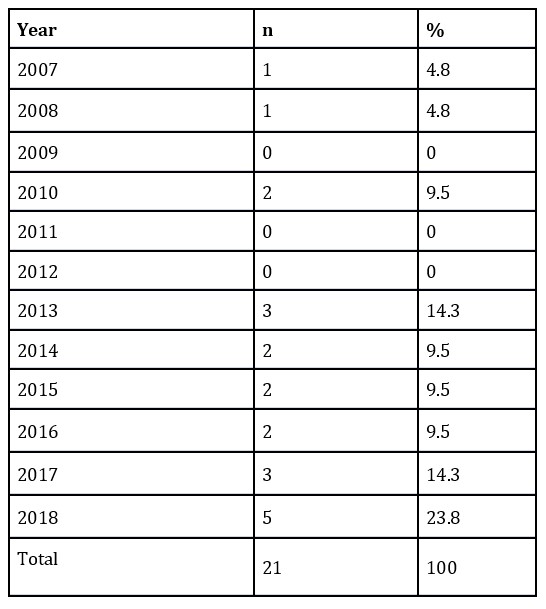
In SLR, the authors’ keywords to categorize published research can also offer clues on what is relevant in a specific research area (figure 2). Not surprisingly, the research in this area is dominated by the keywords “virtual reality” (n=9) and “augmented reality (n=5), with some evidence of human resources management-related keywords.
The geographical distribution of the studies was defined using the first author affiliation. Europe seems to show a greater interest in this area (n=10). However, these data should be taken carefully since several authors published most research with different affiliations (table 2).

Figure 2: Frequency of most used keywords
The categories “type of study” and “research methods used” offer an idea of the research approaches more common when studying the use of VR and AR in HRMD (Table 2). The research is mainly empirical and qualitative in the approach, even though mixed methods is a common option. Most studies focus on applying some solution to a specific context (e.g. 3D simulation as a training tool, VR-based firefighting training, or augmented reality applications in construction project activities), which helps explain the empirical nature of most studies. For the same reason, the qualitative approach’s preference may be anchored on the small-scale nature of the context where the application was made.
Finally, the type of technology and the resources used. Virtual reality is the most common type of technology (n=17). Only one study used both technologies, which might mean that researchers find more potential in applying virtual reality to HRMD than augmented reality. Most studies refer to the use of hardware, as resources, which may be explained by the fact that most studies focus on virtual reality (which demands some hardware).
Table 2: Descriptives of main categories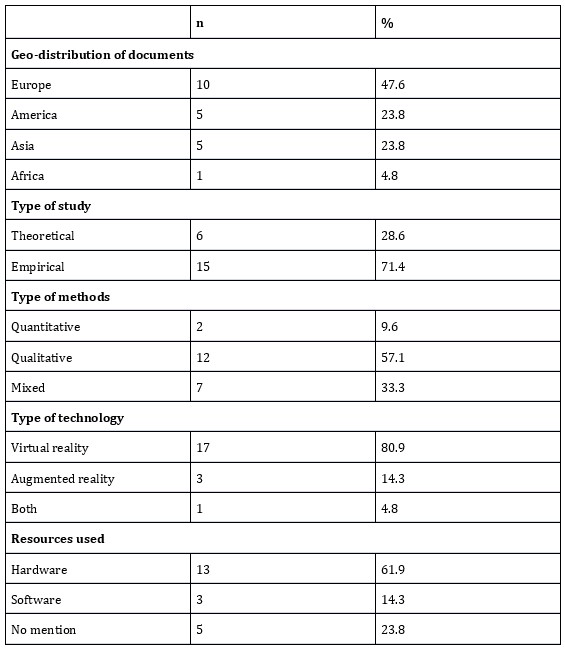
The second part of the analysis aims to offer information about the research’s focus, specifically, the HR processes that were involved and the connection of VR and AR with those processes.
The preferred target of the connection between HR processes and VR and AR is the “learning and development” HR process (Table 3). The long tradition of studies may explain this preference for formal education and training (Psotka, 1995) and the positive results that simulation, immersion, and virtual worlds have on learning outcomes (Merchant et al., 2014). To a lesser extent, other HR areas were also the focus of previous research, such as “health and safety”, “stress management”, and “performance management”.
Table 3: Most mentioned HRMD processes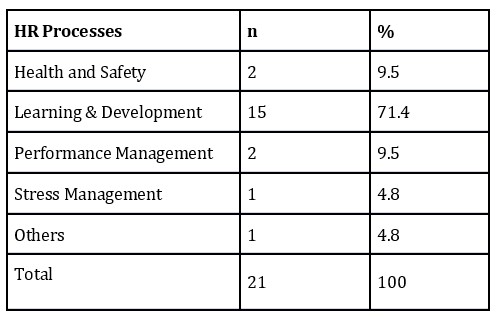
The final group of data is related to the conclusions reported by the research. For this study, the information was grouped into four categories: development, implementation, assessment, and impact (Table 4). These categories are related to this systematic literature review’s goal, namely understanding the process of applying VR and AR to HRMD, its use, and its impact.
Most studies report information about development, implementation, and assessment. Nevertheless, considering that the nature of the categories “development”, “implementation” and “assessment” (Table 4) involves assessing if and how VR and AR can be an efficient solution in several HR processes, the number of studies that show no evidence of development, implementation, or assessment is relatively high.
Finally, the large majority of the studies (n=17) offer information about the impact of VR and AR, which is evidence of the study’s relevance, to improve and expand the knowledge produced. Within the studies reporting information on impact, there is a consensus that VR and AR positively impacted the HR process, with just one study reporting a negative impact.
Table 4: Information reported on the connection between HR processes and Virtual & Augmented Reality
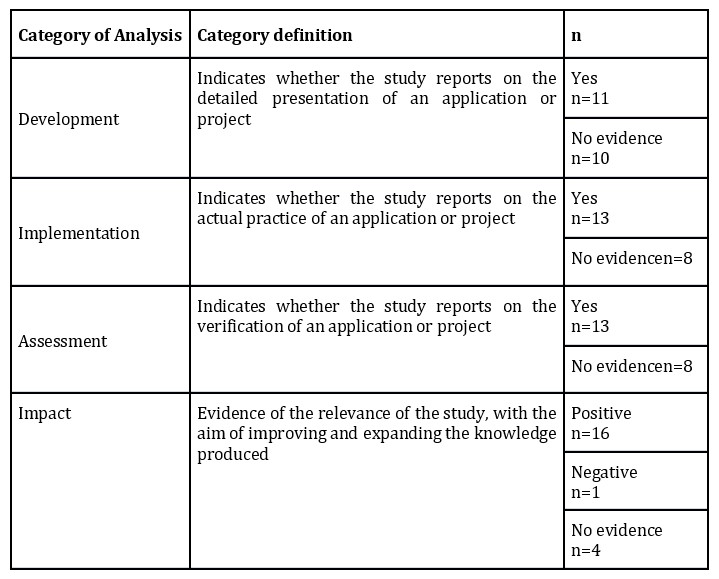
Conceptual and/or theoretical papers underline the potential positive impact of VR, especially for training and competencies development (Table 4).
The articles found in the SLR present and discuss VR solutions’ role in many different professional activities. Bruzzone and Longo (2013) and Bruzzone et al. (2010), by presenting the case of an integrated platform for training and development of a transshipment terminal, discuss the importance of simulation using VR for managers and operators in highly complex environments. On the other hand, Puel et al. (2018) describe an immersive training platform for firefighters, highlighting the importance of plausible and varied behavior of the artificial characters, richness, and variety of the training experience stories. Kivrak et al. (2013) present a project based on AR for enhancing construction workers’ capabilities to perform and supervise in a more efficient, productive, and safer manner. Moon et al. (2015) suggest a methodology based on AR technology for pipe assembly at plant construction sites. Although without empirical findings, they argue that the new management process based on AR technology will reduce errors, omission or rework of tasks, contributing to cost control, productivity, and quality standards. Hannola et al. (2018) take a more general and integrated approach to suggest a framework based on specific digital advancements for the knowledge management processes. The framework highlights how technology can enhance knowledge transfer, discovery, acquisition, and sharing.
For example, Ahmaniemi et al. (2017) developed an experiment to examine the role of VR as a stress recovery instrument. The experience was conducted comparing several physiological indicators when exposed to a VR experience versus an audio-only experience. The results showed that VR experiences were more efficient in reducing work-related stress when compared with a “just audio” stimulus. Another study (Colombo and Golzio, 2016) using Immersive Virtual Environments shows that this environment may help training professionals in decision-making and training teams. The experiment showed the positive potential impact virtual reality could have on operators’ and managers’ competencies based on simulation teaching.
The exception is the study conducted by Bououd et al. (2016). The study aimed to examine the unique characteristics of 3D Virtual Worlds (object manipulation and avatar and 3D environment customization) and social loafing on competencies acquisition. They found that social loafing – exerting less effort to achieve a goal when working in a group – negatively impacts knowledge sharing and application. This finding calls attention to the possible limitation of virtual technologies that promote group work in the context of competencies’ development.
Table 5: Outputs from the SLR and main categories
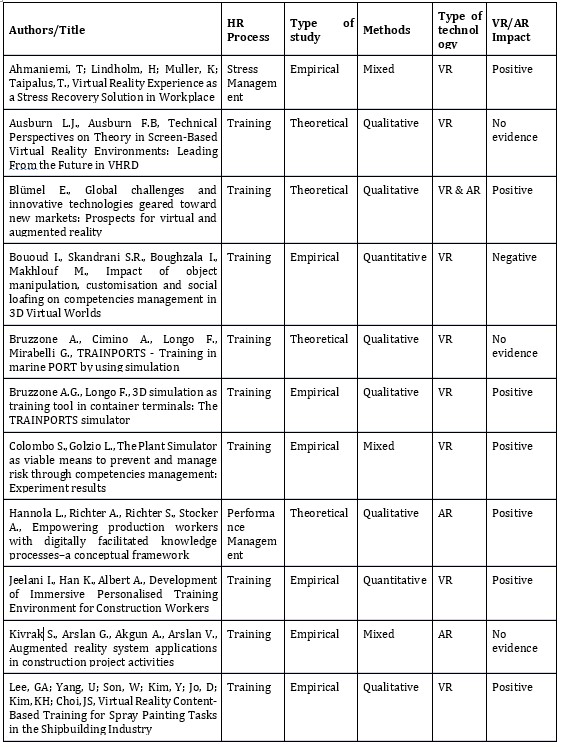
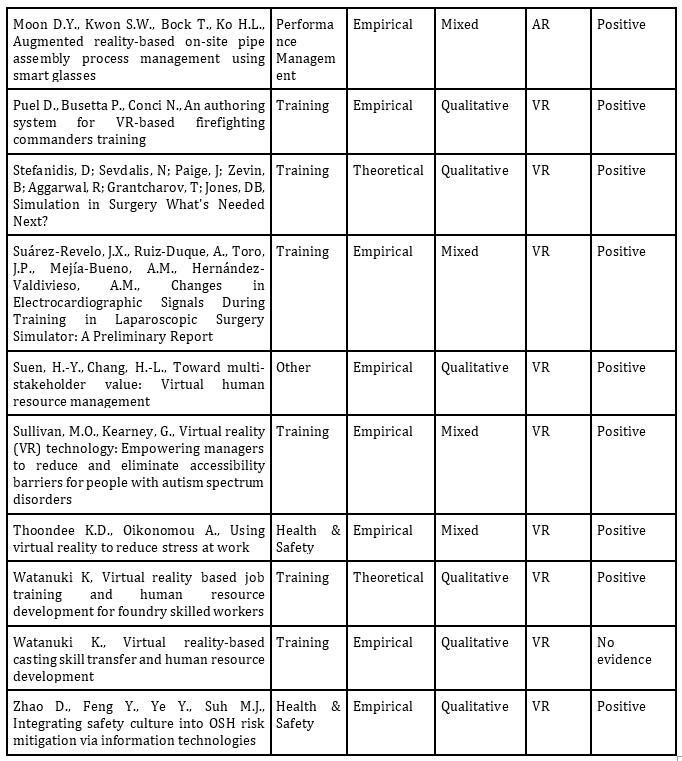
Conclusions
The results of this systematic literature review point to several conclusions, alongside some suggestions for future research in the field of the use and impact of VR and AR in HRMD. The results show an area of research that can be characterized as (1) under-explored, (2) immature, and (3) inconsistent.
The reduced number of publications (n=21) in the past 12 years, with less than two publications per year, is low compared with other systematic literature reviews (see as an, e.g. Macke and Genari, 2019; Tariq et al., 2016). Thus, the low number of publications reveals an under-explored field of study.
The field can also be characterized as immature. The year 2013 seems to mark the relatively steady growth of publications. This means that the study of the use and impact of VR and AR on HRMD is relatively recent, still in its first steps. Also, the majority of studies are empirical and qualitative. The empirical studies under analysis are more concerned with assessing if the technology serves the purpose of HR processes or not than the development of the theory that supports future studies in the field. The preference for qualitative instead of quantitative studies results from applying some VR or AR solution to a specific context. However, it also reveals some immaturity in the field since the reduced number of quantitative studies prevents generalized results to a larger scale.
Finally, the study of the use and impact of VR and AR on HRMD can also be characterized as inconsistent. The number of publications, although with a relatively growing trend since 2013, is inconsistent with no publications in 2 years in a row (the years of 2011 and 2012). But more importantly, the imbalance between studies that focus on VR and AR technology’s impact is quite pronounced. Although this result is consistent with Tori, Kinner, and Siscoutto (2006), namely the use of VR hardware equipment on HR processes, the fact is that the field of study as a whole grows imbalanced.
The more significant number of studies on training and development, alongside the lack of investigation of several HR processes, is another argument that supports some inconsistency in the field of study. Muhanna (2015) and Van Krevelen and Poelman (2010) described the HR processes where VR and AR can be applied, including recruitment and selection, induction and integration, training, employer branding (promoting the company’s brand), organization culture, and mission. This study revealed that only four processes were the focus of published research. Training and development stand out, followed by far by health and safety processes, performance management, and stress management.
The number of studies that show no evidence of development, implementation, or assessment, is relatively high, but the number of studies that report some impact is relatively high. We believe that this is a sign of under-exploration and immaturity of the area. The lack of information about development, implementation, or assessment, reveals that there is no focus on developing and tests new AR and VR solutions, but simply uses what already exists and tests if it works in the context of HR processes. This argument is further supported by the fact that papers are mainly empirical, looking to report VR or AR’s impact on some kind of HR process.
Tavares (2010) stresses that the search for new methods and strategies for organizations to differentiate themselves is increasingly important in the current job market. VR and AR in HR processes can be considered one of those methods due to their immersion and interactivity characteristics. At first sight, the systematic literature review results could seem discouraging, showing an uninteresting scenario. However, this scenario offers several clues for future research.
Being an under-explored area, but with a high level of receptivity, particularly among practitioners, the novelty of possible solutions will certainly be welcomed in the scientific as in the practitioner communities. Nevertheless, it is crucial to offer robust studies with a high degree of generalization and consistent results. This demands more quantitative studies, using larger samples. Additionally, it may be helpful to introduce quasi-experimental studies to compare HR processes’ effects with and without VR and AR solutions. This kind of approach will allow us to isolate the variables induced by the technology’s characteristics; thus better understanding VR and AR’s actual HR processes effectiveness.
As seen in the introduction, VR and AR have some distinctive characteristics, offering different potential benefits. As such, it is essential to develop a balanced understanding of both types of technologies. Another vital research path is the comparative understanding of both technologies as alternative and complementary solutions.
The reduced number of studies reporting development, implementation, and assessment of VR and AR solutions shows one of the most important future research paths. There is a need to develop VR and AR solutions adjusted to HR processes’ reality and constraints. Although assessing the impact of existing solutions is crucial and a significant contribution, software that can take advantage of VR and AR technologies without losing sight of HR processes’ characteristics is of utter importance.
Finally, there is much more in HR than in learning and development. This is not to say that L and D is not a set of important HRMD processes. But from a holistic, integrated, and balanced perspective, it is important to understand how VR and AR can be used in other less obvious areas. This research path will undoubtedly encourage more disruptive and innovative thinking and solutions, thus furthering knowledge in VR and AR’s effective application in HRMD.
Acknowledgement
The authors would like to acknowledge the participation of the following Human Resources Management and Development master students: Andreia Carneiro, Daniel Costa, Daniela Seixas, Liliana Lopes, Maria Clara Figueiredo, Maria Manuela Torres, Maria Valente, Mariana Silva, Mariana Santos, Tiago Correia.
This work is financed by Portuguese national funds through FCT – Fundação para a Ciência e Tecnologia, under the project UIDB/05422/2020.
(adsbygoogle = window.adsbygoogle || []).push({});
References
- Aguinis, H., Henle, C., and Beaty, J. (2001) ‘Virtual reality technology: A new tool for personal selection’, 9 (1/2), 70–83.
- Anthes, C., García-Hernández, R. J., Wiedeman, M., and Kranzlmüller, D. (2016). State of the Art of Virtual Reality Technology. IEEE Aerospace Conference, (pp. 5-12). Montana, USA.
- Ausburn, L. J., and Ausburn, F. B. (2014). Technical Perspectives on Theory in Screen-Based Virtual Reality Environments: Leading From the Future in VHRD. Advances in Developing Human Resources, Vol. 16(3), 371-390.
- Baird, KM and Barfield, W (1999) ‘Evaluating the effectiveness of augmented reality displays for a manual assembly task’. Virtual Reality, 4 (4), 250-259.
- Bennett, EE (2009) ‘Virtual HRD: The Intersection of Knowledge Management, Culture, and Intranets’, Advances in Developing Human Resources, 11 (3), 362–374.
- Cardoso, A, Lamounier Jr, E, Kirner, C and Kelner, J (2007) ‘Tecnologias e Ferramentas para o Desenvolvimento de Sistemas de Realidade Virtual e Aumentada’, Simposium Virtual Reality 2007, Pernambuco, Brasil: Universidade Federal de Pernambuco, 1-19.
- Choi, Y, Vincelli, F, Riva, G, Wiederhold, B, Lee, J and Park, K (2005) ‘Effects of group experiential cognitive therapy for the treatment of panic disorder with agoraphobia’, CyberPsychology & Behavior, 8 (4), 387-393.
- Cook, DJ, Mulrow, CD and Haynes, RB (1997) ‘Systematic Reviews: synthesis of best evidence for clinical decisions’, Ann Intern Med., 126 (5), 376-380.
- Doshi, A, Smith, RT, Thomas, BH and Bouras, C (2017) ‘Use of projector based augmented reality to improve manual spot-welding precision and accuracy for automotive manufacturing’, International Journal of Advanced Manufacturing Technology, 89 (5-8), 1279–1293.
- Hecklau, F, Galeitzke, M, Flachs, S and Kohl, H (2016) ‘Holistic approach for human resource management in Industry 4.0’, 6th CIRP Conference on Learning Factories, Procedia CIRP 54, 1-6
- Higgins, JT and Green, S (2011) Cochrane Handbook for Systematic Reviews of Interventions Version 5.1.0. The Cochrane Collaboration.
- Hou, L, Wang, X and Truijens, M (2015) ‘Using Augmented Reality to Facilitate Piping Assembly: An Experiment-Based Evaluation’, Journal of Computing in Civil Engineering, 29 (1).
- Kietchenham, BA (2007) Guidelines for Performing Systematic Literature Reviews in Software Engineering. Keele University and University of Durham.
- Kirner, C and Kirner, TG (2011) ‘Evolução e Tendências da Realidade Virtual e da Realidade Aumentada’, XIII Simpósio de Realidade Virtual e Aumentada – Realidade Virtual e Aumentada: Aplicações e Tendências, Uberlândia, Brasil: Universidade Federal de Uderlândia, 10-25
- Kivrak, S, Arslan, G, Akgun, A and Arslan, V (2013) ‘Augmented Reality System Applications in Construction Project Activities’, 2013 Proceedings of the 30th ISARC, Montreal, Canadá: The International Association for Automation and Robotics in Construction, 1560-1571
- Liberaty, A, Altman, D, Tetzlaff, J, Mulrow, C, Gotzsche, P, Ioannidis, J and Moher, D. (2009) The PRISMA Statement for Reporting Systematic Reviews and Meta-Analysis of Studies that Evaluate Health Care Interventions: Explanation and Elaboration. BMJ.
- Moher, D, Liberati, A, Tetzlaff, J and Altman, DG (2009) ‘The PRISMA Group: Preferred Reporting Items for Systematic Reviews and Meta-Analyses the PRISMA Statement’. PLoS Med.
- Macke, J and Genari, D. (2019) ‘Systematic literature review on sustainable human resource management’, Journal of Cleaner Production, 208, 806-815
- Merchant, Z, Goetz, ET, Cifuentes, L, Keeney-Kennicutt, W, Davis, TJ (2014) ‘Effectiveness of virtual reality-based instruction on students’ learning outcomes in K-12 and higher education: A meta-analysis’, Computers & Education, 70, 29-40
- Muhanna, MA (2015), ‘Virtual reality and the CAVE: taxonomy, interaction challenges and research directions’, Journal of King Saud University – Computer and Information Sciences, 27, 344-361.
- Oliveira, AM and Oliveira, AJ (2011) ‘Gestão de Recursos Humanos: uma Metanálise de seus Efeitos sobre Desempenho Organizacional’, Revista de Administração Contemporânea, 15, 650-669
- Psotka, J (1995) ‘Immersive training systems: Virtual reality and education and training’, Instructional Science, 23, 405-431
- Sampaio, RF and Mancini, MC (2007) ‘Estudos de Revisão Sistemática: Um Guia para Síntese Criteriosa da Evidência Científica’, Revista Brasileira de Fisioterapia, 83-89.
- Shamim, S, Cang, S, Yu, H and Li, Y (2016)’ Management approaches for Industry 4.0: A human resource management perspective’, 2016 IEEE Congress on Evolutionary Computation (CEC), Vancouver, BC, 5309-5316.
- Sivathanu, B and Pillai, R (2018) ‘Smart HR 4.0 – how industry 4.0 is disrupting HR’, Human Resource Management International Digest, 26 (4), 7-11.
- Stone, D and Deadrick, D (2015) ‘Challenges and opportunities affecting the future of human resource management’, Human Resource Management Review, 139–145.
- Tariq, S, Jan, FA and Ahmad, MS (2016) ‘Green employee empowerment: a systematic literature review on state-of-art in green human resource management’, Quality & Quantity, 50, 237-269
- Tori, R, Kinner, C and Siscoutto, R (2006) Fundamentos e Tecnologia de Realidade Virtual Aumentada. Porto Alegre, Editora SBC.
- Van Krevelen, DW and Poelman, R (2010) ‘A Survey of Augmented Reality Technologies, Applications and Limitations’, The International Journal of Virtual Reality, 9 (2), 1-20.
References used in the Systematic Literature Review
- Ahmaniemi, T, Lindholm, H, Muller, K, Taipalus, T (2017) ‘Virtual Reality Experience as a Stress Recovery Solution in Workplace’. 2017 IEEE LIFE SCIENCES CONFERENCE (LSC)
- Ausburn LJ and Ausburn FB (2014) ‘Technical Perspectives on Theory in Screen-Based Virtual Reality Environments: Leading From the Future in VHRD’. Advances in Developing Human Resources
- Blümel E. (2013) ‘Global challenges and innovative technologies geared toward new markets: Prospects for virtual and augmented reality’. Procedia Computer Science
- Bououd I, Skandrani SR, Boughzala I and Makhlouf M. (2016) ‘Impact of object manipulation, customisation and social loafing on competencies management in 3D Virtual Worlds’, Information Systems Frontiers
- Bruzzone A, Cimino A, Longo F and Mirabelli G (2010) ‘TRAINPORTS – Training in marine PORT by using simulation’, 12th Int. Conference on Harbor, Maritime and Multimodal Logistics Modeling and Simulation, HMS 2010, International Mediterranean and Latin American Modeling Multiconference, I3M 2010
- Bruzzone AG and Longo F (2013) ‘3D simulation as training tool in container terminals: The TRAINPORTS simulator’, Journal of Manufacturing Systems
- Colombo S and Golzio L (2016) ‘The Plant Simulator as viable means to prevent and manage risk through competencies management: Experiment results’, Safety Science
- Hannola L, Richter A, Richter S and Stocker A. (2018) ‘Empowering production workers with digitally facilitated knowledge processes–a conceptual framework’, International Journal of Production Research
- Jeelani I, Han K and Albert A (2017) ‘Development of Immersive Personalised Training Environment for Construction Workers’, Congress on Computing in Civil Engineering, Proceedings
- Kivrak S, Arslan G, Akgun A and Arslan V (2013) ‘Augmented reality system applications in construction project activities’, ISARC 2013 – 30th International Symposium on Automation and Robotics in Construction and Mining, 23rd World Mining Congress
- Lee, GA, Yang, U, Son, W, Kim, Y, Jo, D, Kim, KH and Choi, JS (2010) ‘Virtual Reality Content-Based Training for Spray Painting Tasks in the Shipbuilding Industry’, ETRI JOURNAL
- Moon DY, Kwon SW, Bock T and Ko, HL (2015) ‘Augmented reality-based on-site pipe assembly process management using smart glasses’, 32nd International Symposium on Automation and Robotics in Construction and Mining: Connected to the Future, Proceedings
- Puel D, Busetta P and Conci N (2018) ‘An authoring system for VR-based firefighting commanders training’, IS and T International Symposium on Electronic Imaging Science and Technology
- Stefanidis, D, Sevdalis, N, Paige, J, Zevin, B, Aggarwal, R, Grantcharov, T and Jones, DB (2015) Simulation in Surgery What’s Needed Next?. ANNALS OF SURGERY
- Suárez-Revelo, JX, Ruiz-Duque, A, Toro, JP, Mejía-Bueno, AM and Hernández-Valdivieso, AM (2018) ‘Changes in Electrocardiographic Signals During Training in Laparoscopic Surgery Simulator: A Preliminary Report’, Communications in Computer and Information Science, 916, 279-289
- Suen, H-Y and Chang, H-L (2017) ‘Toward multi-stakeholder value: Virtual human resource management’, Sustainability, 9 (12), 2177
- Sullivan, MO and Kearney, G (2018) ‘Virtual reality (VR) technology: Empowering managers to reduce and eliminate accessibility barriers for people with autism spectrum disorders’, Studies in Health Technology and Informatics, 256, 253-261
- Thoondee KD and Oikonomou A (2018) ‘Using virtual reality to reduce stress at work’, Proceedings of Computing Conference 2017
- Watanuki, K (2007) ‘Virtual reality-based casting skill transfer and human resource development’, Proceedings 17th International Conference on Artificial Reality and Telexistence, ICAT 2007
- Watanuki K (2008) ‘Virtual reality based job training and human resource development for foundry skilled workers’, International Journal of Cast Metals Research
- Zhao, D, Feng, Y, Ye, Y and Suh MJ (2014) ‘Integrating safety culture into OSH risk mitigation via information technologies’, Lecture Notes in Electrical Engineering










